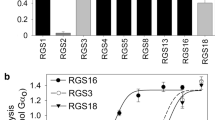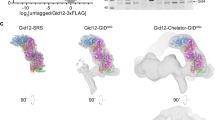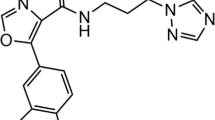Abstract
The specificity and regulation of GSK3β are thought to involve in the docking interactions at core kinase domain because of the particular amino acid residues. Recent X-ray diffraction studies illuminated the relative binding residues on AxinGID and FRATtide for GSK3β docking and appeared that GSK3β Val267Gly (V267G) and Tyr288Phe (Y288F) could distinguish the direct interaction between AxinGID and FRATtide. In order to explore the mode that involved the binding of GSKIP to GSK3β and compare it with that of AxinGID and FRATtide, we pinpointed the binding sites of GSKIP to GSK3β through the single-point mutation of four corresponding sites within GSK3β (residues 260–300) as scaffold-binding region I (designated SBR-I260–300). Our data showed that these three binding proteins shared similar binding sites on GSK3β. We also found that the binding of GSK3β V267G mutant to GSKIP and AxinGID, but not that of Y288F mutant (effect on FRATtide), was affected. Further, based on the simulation data, the electron-density map of GSKIPtide bore closer similarity to the map AxinGID than to that of FRATtide. Interestingly, many C-terminal helix region point-mutants of GSK3β L359P, F362A, E366K, and L367P were able to eliminate the binding with FRATtide, but not AxinGID or GSKIP. In addition, CABYR exhibited a unique mode in binding to C-terminal helix region of GSK3β. Taken together, our data revealed that in addition to the core kinase domain, SBR-I260–300, another novel C-terminus helix region, designated SBR-II339–383, also appeared to participate in the recognition and specificity of GSK3β in binding to other specific proteins.




Similar content being viewed by others

References
Embi N, Rylatt DB, Cohen P (1980) Glycogen synthase kinase-3 from rabbit skeletal muscle. Separation from cyclic-AMP-dependent protein kinase and phosphorylase kinase. Eur J Biochem 107:519–527
Woodgett JR, Cohen P (1984) Multisite phosphorylation of glycogen synthase. Molecular basis for the substrate specificity of glycogen synthase kinase-3 and casein kinase-II (glycogen synthase kinase-5). Biochim Biophys Acta 788:339–347
Frame S, Cohen P (2001) GSK3 takes centre stage more than 20 years after its discovery. Biochem J 359:1–16
Grimes CA, Jope RS (2001) The multifaceted roles of glycogen synthase kinase 3beta in cellular signaling. Prog Neurobiol 65:391–426
Dajani R, Fraser E, Roe SM, Young N, Good V, Dale TC, Pearl LH (2001) Crystal structure of glycogen synthase kinase 3 beta: structural basis for phosphate-primed substrate specificity and autoinhibition. Cell 105:721–732
ter Haar E, Coll JT, Austen DA, Hsiao HM, Swenson L, Jain J (2001) Structure of GSK3beta reveals a primed phosphorylation mechanism. Nat Struct Biol 8:593–596
Polakis P (2000) Wnt signaling and cancer. Genes Dev 14:1837–1851
Hernandez F, Avila J (2008) The role of glycogen synthase kinase 3 in the early stages of Alzheimers’ disease. FEBS Lett 582:3848–3854
Hooper C, Killick R, Lovestone S (2008) The GSK3 hypothesis of Alzheimer’s disease. J Neurochem 104:1433–1439
Thomas GM, Frame S, Goedert M, Nathke I, Polakis P, Cohen P (1999) A GSK3-binding peptide from FRAT1 selectively inhibits the GSK3-catalysed phosphorylation of axin and beta-catenin. FEBS Lett 458:247–251
Li L, Yuan H, Weaver CD, Mao J, Farr GH III, Sussman DJ, Jonkers J, Kimelman D, Wu D (1999) Axin and Frat1 interact with dvl and GSK, bridging Dvl to GSK in Wnt-mediated regulation of LEF-1. EMBO J 18:4233–4240
Salic A, Lee E, Mayer L, Kirschner MW (2000) Control of beta-catenin stability: reconstitution of the cytoplasmic steps of the Wnt pathway in Xenopus egg extracts. Mol Cell 5:523–532
Chou HY, Howng SL, Cheng TS, Hsiao YL, Lieu AS, Loh JK, Hwang SL, Lin CC, Hsu CM, Wang C, Lee CI, Lu PJ, Chou CK, Huang CY, Hong YR (2006) GSKIP is homologous to the Axin GSK3beta interaction domain and functions as a negative regulator of GSK3beta. Biochemistry 45:11379–11389
Dajani R, Fraser E, Roe SM, Yeo M, Good VM, Thompson V, Dale TC, Pearl LH (2003) Structural basis for recruitment of glycogen synthase kinase 3beta to the axin-APC scaffold complex. EMBO J 22:494–501
Fraser E, Young N, Dajani R, Franca-Koh J, Ryves J, Williams RS, Yeo M, Webster MT, Richardson C, Smalley MJ, Pearl LH, Harwood A, Dale TC (2002) Identification of the Axin and Frat binding region of glycogen synthase kinase-3. J Biol Chem 277:2176–2185
Ferkey DM, Kimelman D (2002) Glycogen synthase kinase-3 beta mutagenesis identifies a common binding domain for GBP and Axin. J Biol Chem 277:16147–16152
Hsu HC, Lee YL, Cheng TS, Howng SL, Chang LK, Lu PJ, Hong YR (2005) Characterization of two non-testis-specific CABYR variants that bind to GSK3beta with a proline-rich extensin-like domain. Biochem Biophys Res Commun 329:1108–1117
Hong YR, Chen CH, Chang JH, Wang S, Sy WD, Chou CK, Howng SL (2000) Cloning and characterization of a novel human ninein protein that interacts with the glycogen synthase kinase 3beta. Biochim Biophys Acta 1492:513–516
Hong YR, Chen CH, Cheng DS, Howng SL, Chow CC (1998) Human dynamin-like protein interacts with the glycogen synthase kinase 3beta. Biochem Biophys Res Commun 249:697–703
Cheng TS, Hsiao YL, Lin CC, Yu CT, Hsu CM, Chang MS, Lee CI, Huang CY, Howng SL, Hong YR (2008) Glycogen synthase kinase 3beta interacts with and phosphorylates the spindle-associated protein astrin. J Biol Chem 283:2454–2464
Forde JE, Dale TC (2007) Glycogen synthase kinase 3: a key regulator of cellular fate. Cell Mol Life Sci 64:1930–1944
Nicholas KB, Nicholas HB Jr, Deerfield DW II (1997) GeneDoc: analysis and visualization of genetic variation EMBNET.news, pp 1–4
Berman HM, Westbrook J, Feng Z, Gilliland G, Bhat TN, Weissig H, Shindyalov IN, Bourne PE (2000) The protein data bank. Nucleic Acids Res 28:235–242
Ramelot TA, Cort JR, Xiao R, Shih LY, Ma LC, Acton TB, Montelione GT, Kennedy MA (2005) NMR structure of the human C14orf129 gene product, HSPC210. Northeast Structural Genomics target HR969
Bax B, Carter PS, Lewis C, Guy AR, Bridges A, Tanner R, Pettman G, Mannix C, Culbert AA, Brown MJ, Smith DG, Reith AD (2001) The structure of phosphorylated GSK-3beta complexed with a peptide, FRATtide, that inhibits beta-catenin phosphorylation. Structure 9:1143–1152
DeLano WL (2002) The PyMOL molecular graphics system. DeLano Scientific, Palo Alto, CA
Pettersen EF, Goddard TD, Huang CC, Couch GS, Greenblatt DM, Meng EC, Ferrin TE (2004) UCSF Chimera—a visualization system for exploratory research and analysis. J Comput Chem 25:1605–1612
Weiss B, Jacquemin-Sablon A, Live TR, Fareed GC, Richardson CC (1968) Enzymatic breakage and joining of deoxyribonucleic acid. VI. Further purification and properties of polynucleotide ligase from Escherichia coli infected with bacteriophage T4. J Biol Chem 243:4543–4555
Fields S, Song O (1989) A novel genetic system to detect protein-protein interactions. Nature 340:245–246
Chien CT, Bartel PL, Sternglanz R, Fields S (1991) The two-hybrid system: a method to identify and clone genes for proteins that interact with a protein of interest. Proc Natl Acad Sci USA 88:9578–9582
Zhu L (1997) Yeast GAL4 two-hybrid system. A genetic system to identify proteins that interact with a target protein. Methods Mol Biol 63:173–196
Biondi RM, Nebreda AR (2003) Signalling specificity of Ser/Thr protein kinases through docking-site-mediated interactions. Biochem J 372:1–13
Zhang N, Jiang Y, Zou J, Zhuang S, Jin H, Yu Q (2007) Insights into unbinding mechanisms upon two mutations investigated by molecular dynamics study of GSK3beta–axin complex: role of packing hydrophobic residues. Proteins 67:941–949
Franca-Koh J, Yeo M, Fraser E, Young N, Dale TC (2002) The regulation of glycogen synthase kinase-3 nuclear export by Frat/GBP. J Biol Chem 277:43844–43848
He X, Saint-Jeannet JP, Woodgett JR, Varmus HE, Dawid IB (1995) Glycogen synthase kinase-3 and dorsoventral patterning in Xenopus embryos. Nature 374:617–622
Dominguez I, Itoh K, Sokol SY (1995) Role of glycogen synthase kinase 3 beta as a negative regulator of dorsoventral axis formation in Xenopus embryos. Proc Natl Acad Sci USA 92:8498–8502
Pierce SB, Kimelman D (1995) Regulation of Spemann organizer formation by the intracellular kinase Xgsk-3. Development 121:755–765
van Amerongen R, Nawijn M, Franca-Koh J, Zevenhoven J, van der Gulden H, Jonkers J, Berns A (2005) Frat is dispensable for canonical Wnt signaling in mammals. Genes Dev 19:425–430
van Amerongen R, Berns A (2005) Re-evaluating the role of Frat in Wnt-signal transduction. Cell Cycle 4:1065–1072
Acknowledgments
We thank Dr. C. Liu for his helpful comments on the manuscript and Dr. T.C. Dale for providing many of the plasmids of GSK3β mutant listed in Table 1. This study was supported by NSC 95-2314-B-037-050-MY1 (Taiwan, ROC) to SLH, NSC 96-2320-B-037-004, and MOE 97-U19609-1.1ab-14 to YRH.
Author information
Authors and Affiliations
Corresponding author
Additional information
S.-L. Howng, C.-C. Hwang, and C.-Y. Hsu contributed equally to the work.
Rights and permissions
About this article
Cite this article
Howng, SL., Hwang, CC., Hsu, CY. et al. Involvement of the residues of GSKIP, AxinGID, and FRATtide in their binding with GSK3β to unravel a novel C-terminal scaffold-binding region. Mol Cell Biochem 339, 23–33 (2010). https://doi.org/10.1007/s11010-009-0366-0
Received:
Accepted:
Published:
Issue Date:
DOI: https://doi.org/10.1007/s11010-009-0366-0



